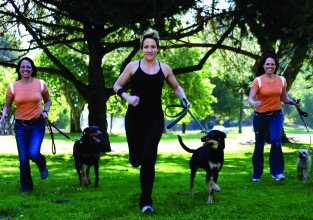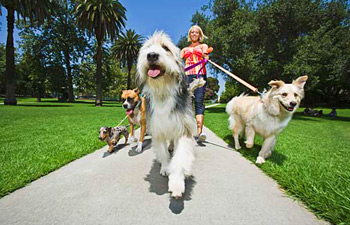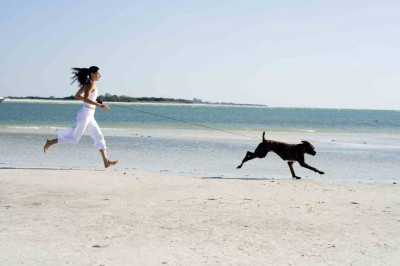
Kimo was a three year old neutered male Malamute dog who dug holes in the yard, barked endlessly, escaped whenever possible, urinated and defecated indoors, and paced relentlessly. Martina was a one year old spayed female Russian Blue cat who meowed for attention at 2 am, knocked objects off any countertop or desktop she explored, and was already two pounds overweight. What could these pets have in common? Do these sound at all like troubles you have had with your own furry friends?
Exercise is one of the best ways to prevent (and treat) common behavior problems in cats and dogs such as house soiling, destructiveness, separation anxiety syndrome, attention seeking nuisance behaviors, compulsivity, and even certain types of aggression. The truth is that most of our pets do not get enough exercise. Historically, cats and dogs did not have their every meal supplied to them without first working hard for it. Domestication certainly has its perks, but we must help our pets to maintain a semblance of a healthy mind, body, and spirit that they once enjoyed before we made them our own.
For dogs of all shapes, sizes and ages, exercise should be accomplished primarily outdoors and in your company:
Leash walks! A morning walk will leave your dog relaxed while you’re away at work. A walk when you return from work will help you both unwind from the stress of the day.
Practice obedience skills during leash walks to increase the benefits of a walk; your dog is not simply ambling along, but is performing additional tasks. Practice commands as a form of constructive play indoors and out so that your dog is always eager to follow your leadership.

Walking your dog is aerobic exercise for you and your dog! Obesity is the most important health problem our pets face. Even aging pets must be kept agile and fit and need your company to encourage their exercise.
Walks give both puppies and adult dogs the opportunity to socialize. The best toy your dog can have is another doggy playmate! With regular opportunity to socialize with people or other dogs, your dog’s social skills will progress.
Play is a great way to exercise your dog. Games of “fetch” are always appropriate. Try building an agility course in your yard.

Cats, too, need to exercise to maintain intellectual, spiritual, and physical well-being. The American Veterinary Medical Association now recommends that all pet cats be confined indoors as house pets for their own safety. This means that your house cat depends on you to provide interesting outlets for all that healthy energy:
Play with your cat at least twice a day until the he (not you) is tired. Be sure to play with your kitty before your bedtime so that you’ll be tired at the same time!
Toys suspended from the end of a “fishing pole” are encouraged because the cat can focus on a moving target that is held away from you.
Provide a wide variety of toys for your cat, and rotate them daily so they retain their appealing novelty. Try making some of your own with household items such as aluminum foil balls or knotted socks on a rope.
Place a cozy perch at several windows around your home. Build a cat “tree” or purchase one so your cat can climb and explore.
Start an aquarium; a fish tank is your kitty’s home entertainment center.
The best toy for a cat is another cat – instead of just one kitten, get two. Introduce new adult pets gradually over many weeks to improve their acceptance into your household.
Your pet’s basic needs do not vary with the thermometer, barometer, calendar, or how rough a day you’ve had. Living with pets is a privilege, not a right. Fill their days with special shared moments. Their lives, and ours, are too short to be taken for granted.
For the Best that Pet Lifestyle and Animal Welfare has to offer follow Wendy Diamond on Facebook, Twitter, and right here at AnimalFair.com!
